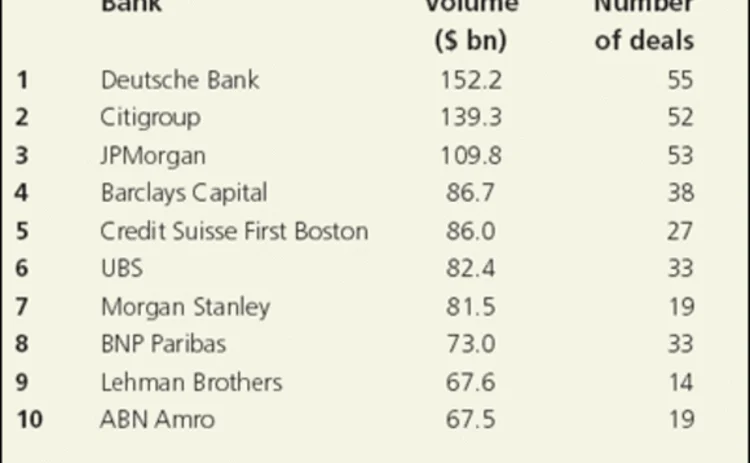
In a differentleague
The issue of bookrunner league tables is one of the corporate bond market’s perennialbugbears. In an effort to unearth a metholodogy that accurately reflects more than justvolume of deals, Credit has come up with a few variations on a theme

Last month Credit asked whether a new issue league table could be produced that gave more insightful information than merely which bank has brought most bonds to market. While such information is interesting in an academic sense, Credit argued it is not really useful in any practical sense to any of the interested parties. Rather, the present league tables disrupt the market, banks waste money buying position in them and borrowers choose the most prolific bookrunner, not necessarily the best.
Instead Credit argued that price performance after issue is at the heart of what makes a bond issue a success or a failure and so should be reflected in the tables. If a deal tightens too much on issue, the borrower has overpaid; if it widens, the investors have allocated their capital in an overvalued asset.
As a follow up, Credit has concocted a methodology that evaluates each bond on four criteria: size, maturity, the after-issue percentage movement in the spread over asset swap, and the proportion of the bond that trades after issue. The data for these criteria is provided by the International Securities Market Association. Scores are then awarded – admittedly subjectively – to each of these factors depending on how well they have performed. These are multiplied together, so any bond that scores zero on any of these factors will score zero overall.
Within this framework, table 2 ranks issuers according to the following criteria: one point is awarded to all bonds that are more than €300 million in size and two points for bonds larger than €1 billion. One point is awarded to new issues with a maturity of more than three years and two points to those with a maturity of 10 years or more. One point is given to those bonds that see an average of 2% turnover or more per trading day over the first two months. And one point goes to those bonds whose spread moves up or down by less than 5% of the launch spread in the first month. (Data on spread performance was provided by the International Securities and Markets Association, an industry trade body that represents assets.)
As a final filter banks have to have completed at least 10 such bonds to be included. In such a league table, looking at investment-grade euro-denominated corporate bonds over the first half of 2003, SG was placed first, Royal Bank of Scotland second, JPMorgan third, Goldman Sachs was fourth and BNP Paribas fifth.
There are of course several drawbacks to this method. First the assigning of points is completely subjective, so any bank can come first if it assigns points to the areas in which it is superior. What’s more, by their very nature the league tables have to be lagging if price and liquidity performance are to be measured.
Nevertheless, these tables can show some interesting statistics. If, as Credit argues,the most important factor for both issuers and buyers of bonds is the after-issueprice performance of a bond – the size and maturity will influence this but are not on their own of paramount concern – banks can be measured on this alone.
So using a similar methodology (see table 3), Credit awarded three points to bonds where the spread moved by less than 5% in its first month; two points where the move was between 5% and 10% of the launch spread in the first month; and those with moves of 10% to 15% received one point. Issues that were smaller than €300 million or with a maturity of less than three years were removed, and banks that had completed less than five such transactions were excluded. In this league table the Italian bank Intesa BCI came first, BNP Paribas second, then Royal Bank of Scotland, SG and BNP Paribas.
Of course these tables do not preclude deals that have been issued but not traded: not of great concern to the issuers but investors will not want illiquid, untradable issues being rewarded in the tables.
To rectify this, the methodology was tweaked to include trading: one point was awarded to bonds that traded an average of 2–5% per day of the outstanding in the first two months, and two points to bonds that saw more than 5% of the outstanding turnover in the first two months. In this table, SG took first place, ING second, Royal Bank of Scotland third, Credit Agricole Indosuez fourth and Intesa BCI fifth.
Interestingly SG, which topped two of our tables, only bookran 11 deals that qualified – a relatively small number.
This attempt at a workable league table methodology is clearly not the final solution, however it does suggest some interesting ideas and produces some interesting questions. For example, which factors should be scored and which ignored? Over what time period should factors such as price performance and turnover be measured? And to what extent does the innate subjectivity in weighting such criteria devalue the tables?
One thing is clear, nobody wants to end up scrapping a flawed method of measuring new issues only to replace it with another. But neither do we want to imagine that just because solutions are not obvious, they do not exist.
Credit welcomes comments or suggestions on the issue of league tables (credit@riskwaters.com)
Only users who have a paid subscription or are part of a corporate subscription are able to print or copy content.
To access these options, along with all other subscription benefits, please contact info@risk.net or view our subscription options here: http://subscriptions.risk.net/subscribe
You are currently unable to print this content. Please contact info@risk.net to find out more.
You are currently unable to copy this content. Please contact info@risk.net to find out more.
Copyright Infopro Digital Limited. All rights reserved.
You may share this content using our article tools. Printing this content is for the sole use of the Authorised User (named subscriber), as outlined in our terms and conditions - https://www.infopro-insight.com/terms-conditions/insight-subscriptions/
If you would like to purchase additional rights please email info@risk.net
Copyright Infopro Digital Limited. All rights reserved.
You may share this content using our article tools. Copying this content is for the sole use of the Authorised User (named subscriber), as outlined in our terms and conditions - https://www.infopro-insight.com/terms-conditions/insight-subscriptions/
If you would like to purchase additional rights please email info@risk.net
More on Rankings
Energy Risk Commodity Rankings 2024: markets buffeted by geopolitics and economic woes
Winners of the 2024 Commodity Rankings steeled clients to navigate competing forces
Energy Risk 2024 Software Rankings: IT demands increase amid rising risk
Heightened geopolitical and credit risk increase requirements on commodities software
Hitachi Energy’s expanded portfolio steers clients through volatility
Three years after acquiring US-based commodities trading and risk management software firm Pioneer Solutions, Hitachi Energy is reaping the rewards of its large portfolio
Ensuring energy technology keeps up with the pace of change
Change may well be a constant in energy markets, but its velocity over the past 18 months has been extraordinary. This has seen KWA Analytics’ clients race to ensure their ETRM infrastructure can keep up – and be ready for change yet to come. Directors…
UBS precious metals team shines amid market turmoil
Global uncertainty always adds allure to precious metals, putting a premium on the long-standing relationships and cutting-edge technology of the UBS precious metals team
Enabling green choices despite market turmoil
Throughout recent market tumult, ENGIE remained committed to net zero, forging even closer connections with clients to fuel global growth
Energy Risk Commodity Rankings 2023: Axpo – the power of partnerships
In the face of recent extreme volatility and price hikes, the strong partnerships Axpo has with its clients has enabled both parties to weather the storm
ION Commodities puts customer engagement at the heart of its business
Sponsored content







